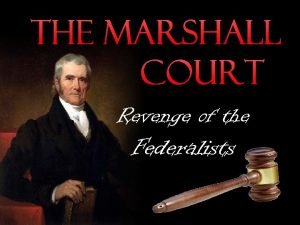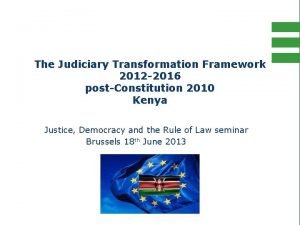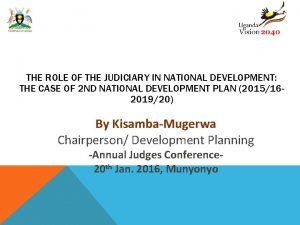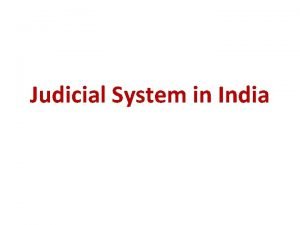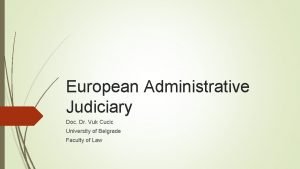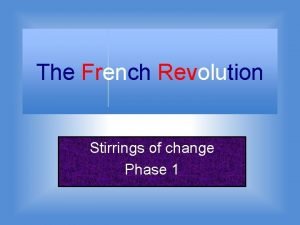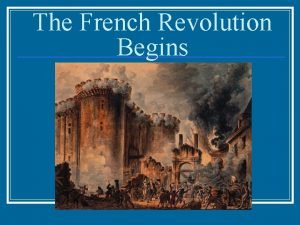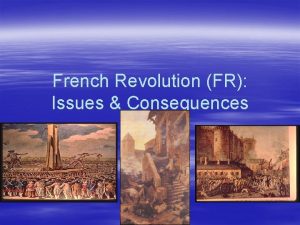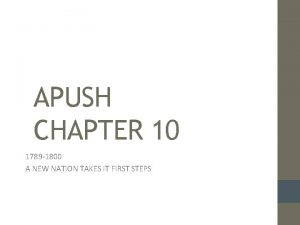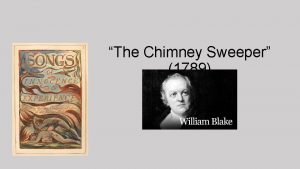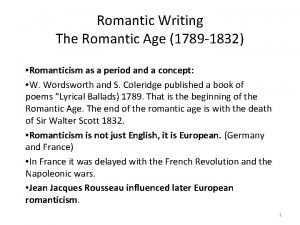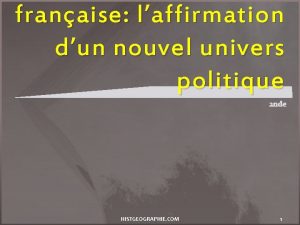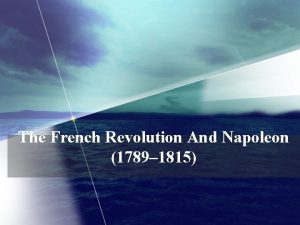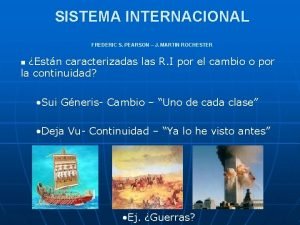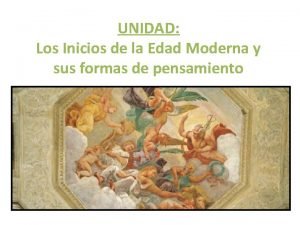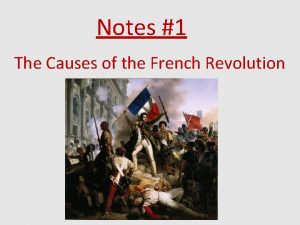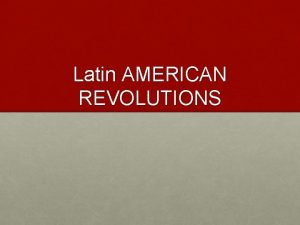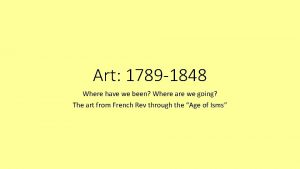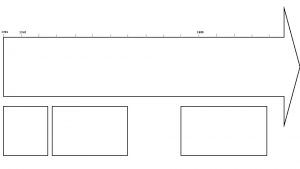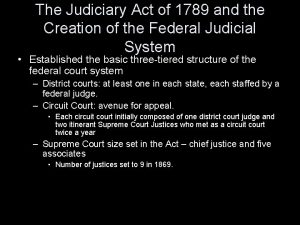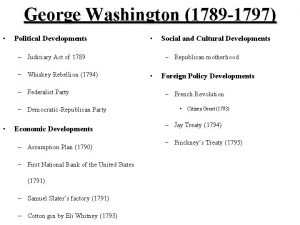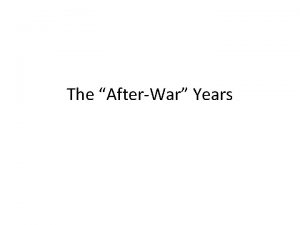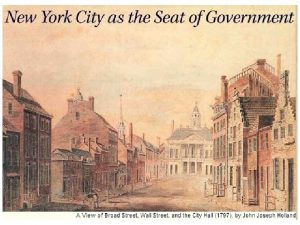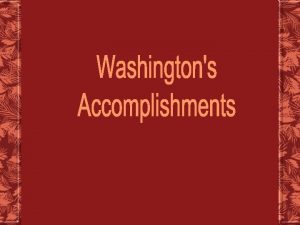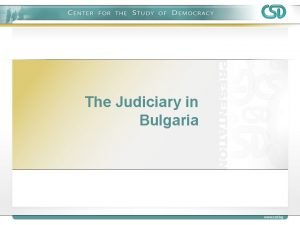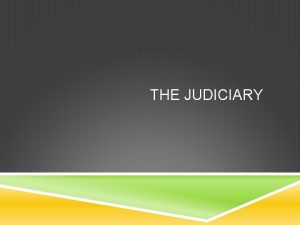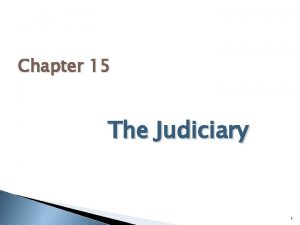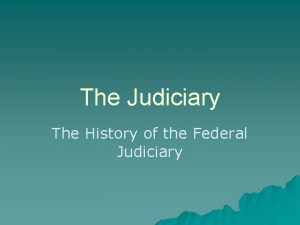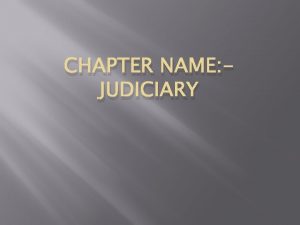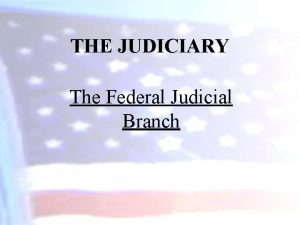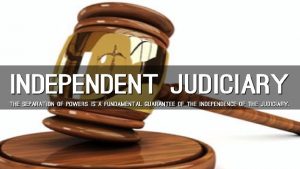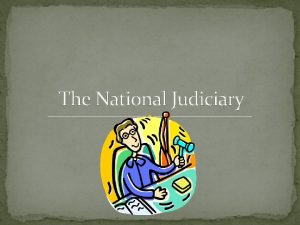The Judiciary 9 Judiciary Act of 1789 and



































































- Slides: 67

The Judiciary 9

Judiciary Act of 1789 and Creation of the Federal Judicial System ¤ Three-tiered Court Structure n Federal District Court n Circuit Courts (Courts of Appeal) n Supreme Court ¤ Rocky beginning for Supreme Court 9. 1

The Marshall Court: Marbury v. Madison and Judicial Review ¤ John Marshall’s tenure: 1801 -1835 n Opinions from the Court, rather than individual justices ¤ Mc. Culloch v. Maryland (1819) n Broad interpretation of “necessary and proper” clause ¤ Marbury v. Madison (1803) n Established Judicial Review 9. 1

The Federal Court System ¤ District Courts ¤ Courts of Appeals ¤ The Supreme Court 9. 2

District Courts ¤ Each state has at least one n More populous states have more 9. 2

District Courts 9. 2 ¤ Jurisdiction n Must involve federal or multistate issue n Generally, n They involve the federal government as a party n they present a federal question based on a claim under the U. S. Constitution, a treaty with another nation, or a federal statute n they involve civil suits in which citizens are from different states and the amount of money involved is more than $75, 000. ¤ U. S. Attorney Generals n Nominated by president; confirmed by Senate

The Courts of Appeals ¤ Eleven Courts of Appeals n A twelfth restricted to federal regulatory commissions and a thirteenth to patents n Job: mainly correct errors of law and procedure ¤ Number of judges varies (6 -30!) n Depends on workload and complexity n Judges are divided in rotating panels ¤ No original jurisdiction n No new testimony n appeals from criminal and civil cases n and appeals from administrative agencies 9. 2

The Supreme Court ¤ Jurisdiction n Reviews cases from U. S. Courts of Appeal and state supreme courts (or other unique courts of last resort) n Sometimes issues are very controversial ¤ Members n Eight associate justices and one chief justice since 1869 n Each justice has 4 clerks and the entire Court employs over 400 staff ¤ Precedent n Rules are binding throughout the nation—it’s not law; it’s establishing precedent n Stare decisis n practice of adhering to precedent when deciding cases 9. 2

The Supreme Court Today ¤ Deciding to Hear a Case ¤ How Does a Case Survive the Process? ¤ Hearing and Deciding the Case 9. 4

Deciding to Hear a Case ¤ Where do cases come from? n The Supreme Court controls its own caseload, deciding which cases it wants to hear and rejecting the rest. n Cases must come from U. S. Courts of appeals or other courts of last resort n Cases must involve a federal question n It’s their time? 9. 4

Deciding to Hear a Case 9. 4 ¤ Writs of Certiorari and the Rule of Four ¤ ¤ Litigants wanting their case to be heard send a petition for a writ of certiorari to SCOTUS It is a request a review of a lower court’s ruling Sent first to the chief justice and then to the other justices the “Rule of Four” means that a case will get a hearing if at least four justices agree. ¤ Role of Clerks ¤ They review cases and make recommendations ¤ generally graduate at the top of their class from top law schools ¤ As more clerks have been hired the length of opinion has greatly increased!

9. 4 FIGURE 9. 2: How Many Cases Does the Supreme Court Handle?

9. 4 FIGURE 9. 3: How Does a Case Get to the Supreme Court?

How Does a Case Survive the Process? Generally a case that is hear by SCOTUS fall into one of three groups ¤ Federal Government is involved n The Solicitor General—the 9½ member, pres appoints n SCOTUS hears 70 to 80% of the cases to which gov. is the petitioning party, compared to about 5% of all other petitioning parties. ¤ Conflicts Among the Courts of Appeal n Different interpretations, precedent setting ¤ Interest Group Participation n Important social issues n record of wide interest group support n amicus curiae 9. 4

9. 4 Argument Calendar

Hearing and Deciding the Case ¤ Oral Arguments 9. 4 n After the court accepts and each side has submitted briefs n Attorneys are given one half-hour to argue their case, including time required to answer questions ¤ The Conference and the Vote n Closed conferences twice a week n with a handshake! n chief justice begins the discussion of the case and each justice speaks in order of seniority n a vote on the case follows ¤ Writing the Opinion n Assignment n The opinion is important because it sets out the legal reasoning justifying the decision, and this legal reasoning becomes a precedent n Dissenting opinions n Concurring opinions

Hearing and Deciding the Case The opinion of the Court

Hearing and Deciding the Case A concurring opinion

Hearing and Deciding the Case A dissenting opinion

Judicial Philosophy, Original Intent, and Ideology ¤ Judicial philosophy and ideology n Judicial restraint n Deference to other branches of government n Judicial activism n justices help create public policy through their decisions ¤ Original intent n Strict constructionism n interpret the Constitution as the Framers wrote and originally intended it n Realistic? Antonin Scalia and Stephen Breyer debate the Constitution www. youtube. com/watch? v=VGKg. Jd. W 55 nc 9. 5

Implementing Court Decisions 9. 6 ¤ Judicial implementation n How judicial decisions are rolled out for the public n Policy must follow in order to implement the decision ¤ Implementing population n Those responsible for carrying out the decision n lawyers, judges, public officials, government agencies ¤ Consumer population n Those directly affected by the decision Before judicial implementation, the following must first be determined: 1. Does the implementing population understand the ruling? 2. Will the implementing population actually follow the ruling? 3. Is the consumer population aware of the rights that the decision grants or denies them?

Discussion Questions 9 What role do the courts play in policy making? Should public opinion be considered when the judiciary makes policy decisions? What are some of the advantages and disadvantages of judicial activism?

Civil Liberties 4

The Incorporation Doctrine: The Bill of Rights Made Applicable to the States 4. 1 ¤ Fourteenth Amendment n Bill of Rights applies to actions of states, not just federal government ¤ Due process clause n Applied to Bill of Rights ¤ Substantive due process

Selective Incorporation and Fundamental Freedoms ¤ Fundamental freedoms protected under selective incorporation ¤ Rights that states must protect: n Freedom of press n Freedom of speech n Freedom of assembly 4. 1

First Amendment Guarantees: Freedom of Religion ¤ The Establishment Clause ¤ The Free Exercise Clause 4. 2

The Establishment Clause ¤ Separation of church and state ¤ Lemon test n Must have secular purpose n Must not advance or prohibit a religion n Must not entangle government with religion 4. 2

Free Exercise Clause 4. 2 ¤ Free exercise clause not absolute n Some religious rites considered illegal n State must provide compelling reason to limit exercise of religion

First Amendment Guarantees: Freedoms of Speech, Press, Assembly, and Petition ¤ Freedoms of Speech and the Press ¤ Protected Speech and Press ¤ Unprotected Speech and Press ¤ Freedoms of Assembly and Petition 4. 3

Freedoms of Speech and the Press 4. 3 ¤ Prior restraint ¤ Alien and Sedition Acts n Censored criticisms of the government ¤ Slavery, Civil War n speech again censored ¤ World War I and anti-government speech

Protected Speech and Press? ¤ Limiting prior restraint ¤ Symbolic speech ¤ Hate speech 4. 3

Unprotected Speech and Press ¤ Unprotected speech n n Libel Slander Fighting words Obscenity 4. 3

Freedoms of Assembly and Petition 4. 3 ¤ Freedom to assemble hinges on peaceful conduct n Subject to rules regarding free speech ¤ Right to petition government about issues

Second Amendment: Right to Keep and Bear Arms ¤ Included to prevent Congress from disarming state militias ¤ Dred Scott v. Sandford (1857) n The right to bear and carry arms is a basic right of citizenship 4. 4

Rights of Criminal Defendants 4. 5 ¤ The Fourth Amendment and Searches and Seizures ¤ The Fifth Amendment: Self-Incrimination and Double Jeopardy ¤ The Fourth and Fifth Amendments: The Exclusionary Rule ¤ The Sixth Amendment: Right to Counsel ¤ The Sixth Amendment: Jury Trials ¤ The Eighth Amendment: Cruel and Unusual Punishment

The Fourth Amendment and Searches and Seizures ¤ Protection from unreasonable searches n Warrants n Probable cause ¤ Drug tests 4. 5

The Fifth Amendment: Self. Incrimination and Double Jeopardy 4. 5 ¤ Protection against self-incrimination ¤ Miranda v. Arizona (1966) n n Right to remain silent Knowledge that what you say can be used against you Right to an attorney present during questioning Right to have an attorney provided if you cannot afford one ¤ Double jeopardy

The Fourth and Fifth Amendments and the Exclusionary Rule ¤ Mapp v. Ohio (1961) ¤ Exceptions to the exclusionary rule n “Good faith” mistakes 4. 5

The Sixth Amendment and Right to Counsel ¤ Sixth Amendment right to attorney n Gideon v. Wainwright (1963) n State must provide attorney for indigent n Right to counsel begins with first appearance before a judge 4. 5

The Sixth Amendment and Jury Trials ¤ Speedy and public trial by impartial jury ¤ Right to confront witnesses ¤ Jury of peers n Racial peers n Gender 4. 5

The Eighth Amendment and Cruel and Unusual Punishment 4. 5 ¤ Cruel and unusual punishment not defined ¤ Furman v. Georgia (1972) ¤ Protecting the wrongfully convicted

Right to Privacy ¤ Birth Control ¤ Abortion ¤ Homosexuality 4. 6

Birth Control ¤ Right of women to obtain contraceptives ¤ Griswold v. Connecticut (1965) 4. 6

Abortion ¤ Roe v. Wade n Prohibits state bans on abortion ¤ Planned Parenthood v. Casey (1992) n Restrictions cannot place “undue burden” on woman 4. 6

Homosexuality 4. 6 ¤ Right to privacy extends to private sexual behavior ¤ Lawrence v. Texas (2003)

Civil Rights 5

The First Civil Rights Movement: Abolition and Women’s Rights ¤ The American Anti-Slavery Society n William Lloyd Garrison n Arthur Tappan ¤ Seneca Falls Convention n Elizabeth Cady Stanton n Lucretia Mott ¤ Sojourner Truth: “Ain’t I a Woman? ” 5. 1

The Civil War and Its Aftermath: Civil Rights Laws and Constitutional Amendments ¤ Thirteenth Amendment n Black Codes ¤ Fourteenth Amendment n Equal Protection Clause ¤ Fifteenth Amendment n Excluded women n National Woman Suffrage Association 5. 1

Civil Rights, Congress, and the Supreme Court 5. 1 ¤ Civil Rights Act of 1875 n Equal access to public accommodations ¤ Reconstruction (federal occupation of the South) ended 1877 ¤ Jim Crow laws n Poll taxes n Grandfather clause

Litigating for Equality ¤ Test Cases n Challenged constitutionality of segregated law schools n NAACP Legal Defense and Educational Fund ¤ Brown v. Board of Education (1954) n Struck down “separate but equal” 5. 2

5. 3 The Civil Rights Movement ¤ ¤ ¤ School Desegregation After Brown A New Move for African American Rights Formation of New Groups The Civil Rights Act of 1964 Statutory Remedies for Race Discrimination

5. 3 School Desegregation After Brown ¤ 'With all deliberate speed' n Brown not immediately implemented ¤ Cooper v. Aaron (1958)

A New Move for African American Rights ¤ Rosa Parks n Boycott of the Montgomery city bus system ¤ Segregated bus system ruled unconstitutional 5. 3

5. 3 The Civil Rights Act of 1964 ¤ March on Washington for Jobs and Freedom (1963) n Martin Luther King, Jr. 's, "I Have a Dream" speech ¤ President Lyndon B. Johnson's priority n Longest filibuster in Senate history

Statutory Remedies for Race Discrimination ¤ Education n Department of Justice could bring cases against school districts n De jure discrimination versus de facto discrimination ¤ Employment n "Business necessity" of practices that excluded African Americans 5. 3

5. 6 Civil Rights and Affirmative Action ¤ Affirmative action n Equality of opportunity ¤ Regents of the University of California v. Bakke (1978) n Racial quotas unconstitutional but race can be considered when accepting applicants

5. 4 The Women's Rights Movement ¤ The Equal Rights Amendment ¤ The Equal Protection Clause and Constitutional Standards of Review ¤ Statutory Remedies for Sex Discrimination

5. 4 The Equal Rights Amendment ¤ Two key provisions n Equality of rights under the law shall not be denied or abridged by the United States or by any state on account of sex. n The Congress shall have the power to enforce, by appropriate legislation, the provisions of this article. ¤ Roe v. Wade n Eroded support for Equal Rights Amendment

The Equal Protection Clause and Constitutional Standards of Review ¤ Levels of scrutiny n n Suspect classifications Strict scrutiny Intermediate scrutiny Rational basis 5. 4

TABLE 5. 1 What are the standards of review fashioned by the Court under the Equal Protection Clause? 5. 4

Statutory Remedies for Sex Discrimination ¤ Equal Pay Act of 1963 n Requires equal pay for equal work ¤ Title VII of Civil Rights Act of 1964 n Prohibits gender discrimination by employers ¤ Title IX of the Education Amendments of 1972 n Bars educational institutions that receive federal funds from discriminating against female students 5. 4

5. 5 Other Groups Mobilize for Rights ¤ ¤ ¤ Hispanic Americans American Indians Asian and Pacific Island Americans Gays and Lesbians Americans with Disabilities

Hispanic Americans ¤ Hernandez v. Texas (1954) n Jury should include other Mexican Americans ¤ César Chávez n United Farm Workers Union ¤ Mexican American Legal Defense and Educational Fund (MALDEF) 5. 5

5. 5 American Indians ¤ Northwest Ordinance of 1787 ¤ specified that "good faith should always be observed toward the Indians, " ¤ Dawes Act (1887) ¤ forced assimilation by requiring, among other things, that children be sent away to boarding school. ¤ Native American Rights Fund (1970) ¤ Bury My Heart at Wounded Knee ¤ mobilize public support against oppression of American Indians the way Uncle Tom's Cabin had for slaves

5. 5 Asian and Pacific Island Americans ¤ Pan-Asian identity n Difficult to forge ¤ Free migration to support railroad n Chinese Exclusion Act ¤ World War II n Korematsu v. U. S. n Civil Liberties Act

Gays and Lesbians ¤ Don't Ask, Don't Tell n Revised prohibition of gays in military n Ended in 2010 ¤ Lawrence v. Texas (2003) ¤ Same-sex marriage n Obergefell v Hodges 5. 5

Americans with Disabilities ¤ Disabled veterans n Returning from Korea and Vietnam ¤ Americans with Disabilities Act n Legal protections against discrimination ¤ American Association of People with Disabilities n Advocacy group 5. 5
 Whats the judiciary act
Whats the judiciary act Jusicial restraint
Jusicial restraint Safe public and fair judiciary
Safe public and fair judiciary Judiciary transformation framework
Judiciary transformation framework Department of judiciary
Department of judiciary Judicial hierarchy in india
Judicial hierarchy in india Judiciary
Judiciary Macbeth summary
Macbeth summary October 6 1789 french revolution
October 6 1789 french revolution The french revolution political cartoon
The french revolution political cartoon Europe in 1789
Europe in 1789 Convention of 1800 apush
Convention of 1800 apush Symbol of the french revolution
Symbol of the french revolution Chimney sweeper songs of innocence
Chimney sweeper songs of innocence Bolton romanticism amp; politics 1789 1832 download
Bolton romanticism amp; politics 1789 1832 download Louis xiv en costume de sacre symboles
Louis xiv en costume de sacre symboles Napoleon 1789
Napoleon 1789 Martin rochester
Martin rochester Europa en 1789
Europa en 1789 What was an immediate cause of the 1789 french revolution
What was an immediate cause of the 1789 french revolution Linea de tiempo edades
Linea de tiempo edades May 1789 french revolution
May 1789 french revolution 2nd estate
2nd estate The divisions in spanish colonial society 1789
The divisions in spanish colonial society 1789 1797 - 1789
1797 - 1789 July 14 1789
July 14 1789 1789 france
1789 france Against the gods 1789
Against the gods 1789 Art 1789
Art 1789 1789
1789 Hình ảnh bộ gõ cơ thể búng tay
Hình ảnh bộ gõ cơ thể búng tay Lp html
Lp html Bổ thể
Bổ thể Tỉ lệ cơ thể trẻ em
Tỉ lệ cơ thể trẻ em Voi kéo gỗ như thế nào
Voi kéo gỗ như thế nào Chụp tư thế worms-breton
Chụp tư thế worms-breton Chúa yêu trần thế
Chúa yêu trần thế Các môn thể thao bắt đầu bằng tiếng chạy
Các môn thể thao bắt đầu bằng tiếng chạy Thế nào là hệ số cao nhất
Thế nào là hệ số cao nhất Các châu lục và đại dương trên thế giới
Các châu lục và đại dương trên thế giới Công của trọng lực
Công của trọng lực Trời xanh đây là của chúng ta thể thơ
Trời xanh đây là của chúng ta thể thơ Mật thư tọa độ 5x5
Mật thư tọa độ 5x5 Làm thế nào để 102-1=99
Làm thế nào để 102-1=99 Phản ứng thế ankan
Phản ứng thế ankan Các châu lục và đại dương trên thế giới
Các châu lục và đại dương trên thế giới Thể thơ truyền thống
Thể thơ truyền thống Quá trình desamine hóa có thể tạo ra
Quá trình desamine hóa có thể tạo ra Một số thể thơ truyền thống
Một số thể thơ truyền thống Cái miệng nó xinh thế
Cái miệng nó xinh thế Vẽ hình chiếu vuông góc của vật thể sau
Vẽ hình chiếu vuông góc của vật thể sau Nguyên nhân của sự mỏi cơ sinh 8
Nguyên nhân của sự mỏi cơ sinh 8 đặc điểm cơ thể của người tối cổ
đặc điểm cơ thể của người tối cổ Ví dụ giọng cùng tên
Ví dụ giọng cùng tên Vẽ hình chiếu đứng bằng cạnh của vật thể
Vẽ hình chiếu đứng bằng cạnh của vật thể Tia chieu sa te
Tia chieu sa te Thẻ vin
Thẻ vin đại từ thay thế
đại từ thay thế điện thế nghỉ
điện thế nghỉ Tư thế ngồi viết
Tư thế ngồi viết Diễn thế sinh thái là
Diễn thế sinh thái là Các loại đột biến cấu trúc nhiễm sắc thể
Các loại đột biến cấu trúc nhiễm sắc thể Số.nguyên tố
Số.nguyên tố Tư thế ngồi viết
Tư thế ngồi viết Lời thề hippocrates
Lời thề hippocrates Thiếu nhi thế giới liên hoan
Thiếu nhi thế giới liên hoan ưu thế lai là gì
ưu thế lai là gì Sự nuôi và dạy con của hổ
Sự nuôi và dạy con của hổ
